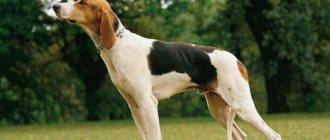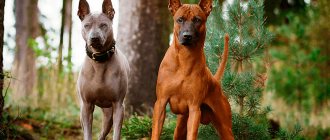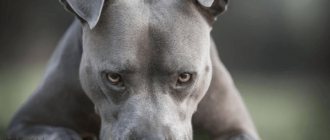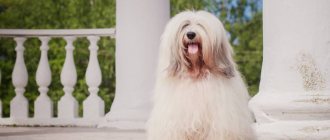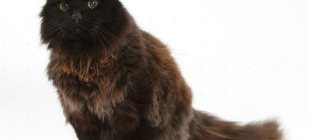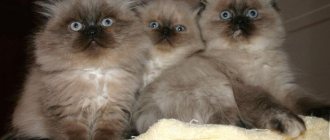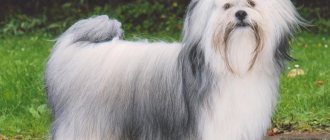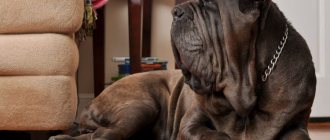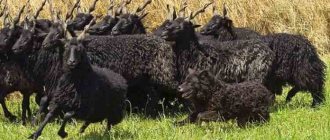Dog hunting, which was previously only the domain of the upper classes, has become much more accessible these days. And the choice of hunting dogs (from wolfhounds to greyhounds) will pleasantly please you not only with their excellent exterior (the appearance of the dogs), but also with decent working qualities. Of all the variety of breeds, it is worth noting such as the Russian Piebald Hound (also known as the Anglo-Russian Hound).
Brief history of the breed
Hunting with hounds was originally the domain of aristocrats, and the work of hounds was considered auxiliary and only the quality of the pack’s work was assessed. It was at this time (or more precisely, in 1810) that the first mentions of Russian piebald hounds appeared. The breed was developed completely by accident, by infusing Russian hounds with the blood of foxhounds, which were extremely popular at that time. It is thanks to Foxhounds that this breed is also called Anglo-Russian. It was only by 1925 that the Russian piebald was officially recognized and began to be bred.
a brief description of
- Other names: Russian Piebald Hound, Gontchaja russkaja pegaja, Russian harlequin hound, English-Russian Hound, English-Russian hound, Russian piebald.
- Height: up to 68 cm.
- Weight: up to 30 kg.
- Color: body black and piebald with tan, perhaps gray-piebald or crimson-piebald with slight speckling, limbs and belly are white.
- Coat: short on the head, 5-6 cm along the body, soft, short, dense undercoat.
- Life expectancy: up to 13 years.
- Advantages of the breed: Brave hunter and devoted friend. The dog is a passionate, dexterous, agile dog for energetic and active people who prefer hunting red animals.
- Difficulties : The dog is prone to escape due to its hunting instinct.
- Price: up to $500.
How can an Anglo-Russian hound help a hunter?
Rather, the question should be posed this way: is it necessary to use dogs for hunting? After all, keeping them is troublesome: you have to feed them, walk them, teach them, and in the 21st century, you can easily use some kind of gadget instead of dogs. For example, a night vision device or a thermal imager.
Dog lovers will answer unequivocally: it is necessary! And there are several reasons for this:
- The dogs will find the game. Of course, relying on hunting experience and technological progress, you can search for game on your own, especially large ones, but when it comes to birds or hares, even modern technologies can’t always help. But the dogs will find the game, and (in the case of hounds) drive the hunter out.
- The dogs give time to prepare for the shot. If the hare actually breaks away from under your feet, then you are unlikely to have time to aim or shoot. The hound will help “lift” him and bring him straight to you. All that remains is to prepare properly and wait.
- The dogs will bring game. Especially useful when hunting in deep snow or other conditions that make movement difficult. In addition, the chance of loss will be significantly reduced.
- A faithful dog is man's best friend. And no gadget can replace this.
- Hunting with a hound will bring much more drive and pleasure from the process than a simple trip with a gun.
However, hunting with a dog also has its disadvantages:
- An inexperienced hunter, who does not know the animal and its habits well, would rather spoil the dog than train it.
- Some animals are better hunted without using hounds.
- Training requires patience and a certain amount of tolerance.
- Some dogs may have birth defects that make training or rutting difficult.
Character and temperament
Outside of the hunting process, piebalds are calm and even lazy creatures; they do not cause any special problems, however, they have some features that the owner will have to get used to. In their free time from running, they prefer to accumulate energy, which they splash out in full on the next hunting trip. Consequently, they are practically not active at home.
These animals are too independent and independent, so they will never do what they try to force on them. For example, instead of humiliating themselves and begging for food, as many other dogs do, they will choose to take it without permission. In addition, they will not be shy to do this right in front of their owner and the entire family as a whole.
What is the best Russian piebald hound to hunt?
The hound is considered a universal dog, capable of hunting any forest inhabitants, but hounds perform best in hunting hare, fox, wolf, raccoon dog and wild boar.
However, remember that if the hounds are accustomed to hunting wild boar (which usually takes place in open areas), then they will get used to a simple and completely unpretentious rut. If they have to hunt more cautious and cunning animals (for example, foxes or hares), then serious difficulties will arise.
Description of the main characteristics of the hound:
- viscosity (perseverance in pursuit);
- fidelity (barks only at the hunted game);
- crawling (ability to find game);
- Paratus (fast rut);
- restlessness (tirelessness during prolonged pursuit);
- good voice (strong, clear, musical and ringing bark);
- skill (work skill);
- good instinct;
- gregariousness (the ability to drive an animal in a pack or in a band, without separating from each other);
- quarrelsomeness (quick gathering of a bow or flock);
- evenness of legs (cohesion of the flock);
- urge (obedience to a challenge);
- politeness (obedience to the hunter, as well as indifference to livestock).
Russian piebald hounds: features and character
- Calm and balanced character.
- The Russian Piebald Hound can withstand enormous physical exertion, but do not overuse it, otherwise the dog may lose interest in the rut or simply become spoiled.
- Excellent sense of smell. It is difficult even for experienced foxes to throw off the scent of a well-trained hound.
- She has a strong voice, so when hunting she will easily give a signal to her owner.
- Doesn't bark or show aggression without a reason.
- The breed is short-haired, which means there will be fewer problems with cleaning the premises during shedding.
Appearance
Despite their recognition, similar features of the Russian Pinto and Foxhounds are clearly visible even in the photo. According to the generally accepted characteristics of the breed, the Russian Piebald Hound is a balanced and intelligent dog, of medium but strong build. The exterior is typical for hounds. The sexual type is well defined, males are larger, shorter with a wider head and bone structure. The weight is not specified in the standard, but ranges from 25–30 kg.
Height and elongation index are the main indicators when assessing dimensions:
- Male – 58–68 cm; 104.
- Bitch – 55–65 cm; 103–105 depending on height and proportions.
Breed standard
- The head has clear silhouette lines and is not too heavy. The skin is “dry”, emphasizing the straight lines of the skull. The occipital protuberance is moderately developed, the forehead is flat, long, but not wide. The transition to the bridge of the nose is pronounced, but without a sharp angle. The muzzle is wedge-shaped with a vertical edge. The lower jaw is rounded. The eye sockets are poorly defined, the cheeks and cheekbones are flat. The lips are thin and well-fitted. The lower lip is slightly fleshier than the upper lip.
- The teeth are well developed, large, white, the upper and lower incisors are parallel. The closure of the teeth is correct, scissor-shaped, without a gap between the upper and lower incisors.
- The nose is large and black.
- The eyes are quite large, expressive, set wide and at medium height. The incision is oval (slanting is allowed). The color of the iris is as saturated as possible, dark, in a brown tone.
- The ears are of medium size and thickness, lowered to the cheeks. Triangular shape, rounded tip. A fold is allowed. While working and concentrating, the ears are turned forward.
- The body is rectangular in shape, with a well-developed skeleton and muscular system. The neck is oval, set at an angle of 40–45°, and its length is almost equal to the distance from the back of the head to the tip of the nose. The withers are massive and well developed, especially in males. The chest is elbow deep, rounded with wide springy ribs. The back line is quite short with a pronounced, rounded loin and a powerful sloping croup. The shoulder girdle is positioned 1–2 cm above the croup. The groin line is moderately tucked.
- The limbs are strong, with pronounced muscles and joints, set harmoniously and quite widely. The height of the front legs is 1/2 the height of the dog at the withers. The shoulders are well developed, the shoulder blades are inclined to the body at almost 100°. The forearms are strong and oval. Elbows point back. The wrists are vertical to the ground. The hind legs are extended beyond the line of the croup, strong, with pronounced bones. The thigh is elongated, the stifle joint is at an open angle, the hock joints are directed back. The metatarsals, like the carpus, are vertical.
- The tail is only in its natural form, powerful, tapering to the tip. When at rest it is carried low, when working or moving it is set upright, the shape is saber-shaped.
Russian pinto hound puppies
If you are planning to get a puppy, then when choosing one you should pay attention to:
- Papers. Study the pedigree, it is recommended - up to 4 generations. “C” students can give weak offspring, given the increased number of frauds at exhibitions, give preference to “excellent” students. Be sure to find out whether the puppies had cattlemen in their family (those who attacked domestic animals) and silent ones (they drove the animal silently, without barking). If there is at least one such ancestor, you should not take a puppy.
- Mother. Must be thin, but not emaciated, contented, and not exhibit any behavioral abnormalities.
- Appearance of a puppy. Well-fed, cheerful, active, agile and, naturally, clean.
- Room. Dry and quite spacious.
Mating
To select a suitable batch, contact kennel clubs. It is unacceptable to look for a partner based on an advertisement on the Internet or through friends. Only in the club can you get reliable information about the health and pedigree of the “groom” or “bride”.
The partner for mating must be “vocal,” that is, have a melodic, drawn-out, melodious bark, characteristic only of the Russian piebald hound breed.
The best age for a bitch to mate and bear offspring is from one and a half to six years. At this time, dogs are in full bloom. Earlier or later matings can provoke premature birth or the appearance of weak offspring.
At the time of mating, the bitch must be treated for fleas and helminths. It is better to double-check that you have all the necessary vaccinations. Only in this case can the mother provide the puppies with her immunity during the first 8 weeks of the babies’ lives. Mating is done in the morning; the animals are not fed. They are allowed to walk as much as possible. The bitch arrives in the dog's territory. They are given time to get to know each other. If it is a male dog's first mating, then he may need human help. The dogs are placed side by side and the male is helped to put his paws over his back. Control mating is carried out after one to two days.
Care
The Russian piebald is extremely unpretentious; it can be brushed quite rarely (once every few days), and bathed as needed. Given their calm nature, such dogs get along well with children, but they are very active, and they require either frequent active walks (when the owner plays with the dog or lets it off a leash) or a large living space (the yard of a private house or cottage).
You should not show weakness or indulge the dog’s whims, otherwise the piebald hound will later become completely disobedient.
Also, you should not deceive her by calling her to you or in any other cases. If the dog distrusts you, then it will take a long time to learn and be reluctant to follow commands.
The last rule is not to “humanize” the dog. Do not let her sleep on the bed, eat from the table, do not try to comfort an upset animal of any breed with affection, etc.
How to care for a dog?
Raising and caring for a pet is quite difficult. It is imperative to follow the rules that will help you establish contact with the animal and raise a loyal, intelligent and useful dog.
The hound must immediately respond to its owner's call. She knows for sure that her master is a leader, but he will not hurt her. With proper upbringing, the pet will follow all commands flawlessly. The dog is very sensitive to the manifestation of care and concern. She loves affection, and will be devoted to all family members until the end of her life. However, there is no need to keep a hound with other animals, as it will not be able to get along with them.
Like the British hound, the Russian piebald hound has a rather short but thick coat. Therefore, there is no need to comb the animal too often. This procedure should be carried out once a week. To do this, use a soft brush. During the molting period, it is better to use a furminator.
As mentioned above, you should not trust children to walk your dog. Russian hounds can be hostile to all strangers, which makes walking very difficult. During the walk you must use a special harness. The dog will be able to run around to his heart's content outside the city or in a deserted park.
It takes a hound 8 hours to digest food. Feeding once a day is unacceptable, as the animal will be very hungry. The required amount of food should be divided into 4 meals. Since the breed is a hunting breed, meat and beef bones come first. Small bones should be excluded from the diet forever. It is better to include vegetables and milk porridges in the menu. Give your pet some dry food several times a week. Spices, sweets, salt, smoked meats, and vinegar are prohibited.
Training
Russian Pinto Hound puppies train best when they are three months old. From this time until 3.5 months or a year, depending on the approach to training (Training is the development of the hound’s innate skills and consolidation of the developed ones), it is necessary to teach the puppy the commands “Come to me!” "Stand!" and others included in the OKD (general training course), as well as accustom to the sound of a horn and a shot.
To train a hound to listen to a horn, you need to blow it before feeding, and blow it on the same horn, the sound of which the piebald hound will remember forever, and when hunting, it will never confuse the sound of the horns. You should not blow the horn all day long, otherwise the dog will lose all interest in it and become uncontrollable in the forest. This, in turn, can not only ruin the pleasure of hunting, but also lead to the death or loss of the dog.
The next step is to teach the dog the command “Open!” (to make the dog throw the food). After training, you will be able to safely take prey while hunting. Before feeding, the animal is tied to a long leash (from 5 to 8 meters), threaded through a ring fixed in the wall, and the end of the leash remains in the hands of the owner. Throw some treat and give the command “Discover!” If the hound bares its teeth and growls, then pull the dog to the ring with one hand, and take the bone with the other. Russian pinto hound puppies usually understand the command 2-3 times, however, if the puppy persists, as an exception, you can lightly punish him. After completing the command correctly, praise the dog and give it a treat (but not the one you took away, of course).
From a very early age, it is necessary for your Russian Piebald to become accustomed to being polite (a term described in “Basic Characteristics”) and not attacking livestock and/or your other pets. If a dog manages to kill any domestic animal at least once and is not punished, then this vice will remain with it for the rest of its life.
Therefore (especially if the dog is vicious, or you live in the city), try to bring the dog near livestock and birds and patiently teach it complete indifference by pulling back or punishing it.
Maintenance and care
Russian piebalds are dogs that are well adapted to any weather conditions. They are not particularly demanding in terms of care, but some rules must be followed.
The animals are distinguished by their beautiful appearance and good working qualities.
Hygiene
It is necessary to bathe the dog only when necessary; puppies are not washed until they reach the age of three months. During shedding, the fur needs to be brushed. It is important to monitor your pet's eyes - they are susceptible to conjunctivitis. They are washed with special solutions. Ears are examined and cleaned as needed.
Nails are trimmed only if the dog does not have time to sharpen them on his own.
Walking, physical activity and rules of safe behavior on the street
The Russian Hound is a very active dog. You need to walk with her at least three times a day, even if the dog lives in an enclosure. Animals need constant physical activity, long runs and active games in the fresh air.
Note! Walking without a leash is allowed only in deserted areas. In addition, you need to make sure that cats or small animals do not appear and the dog does not start hunting for them.
Features of feeding and diet
It is best to give such dogs lean raw meat along with cereals and vegetables - this is the best diet option. During the hunting period, there should be more meat products or by-products in the diet.
It is allowed to give the dog fermented milk products, cheese, rye and wheat crackers.
Dogs need to spend long periods of time outside, running and playing a lot.
Catch-up
A puppy of any breed can be introduced to the forest at the age of 4 months, but walks should last about an hour and not turn into a challenge, otherwise there is a high risk of overworking the puppy and causing him to become disgusted with the process.
By 8-9 months, subject to the above-mentioned requirements, training can begin. Many authoritative experts recommend starting training at one year old, arguing that any breed of hound reaches the necessary physical development at this time. Naturally, you can start training earlier, but if you value your pet, it is better to wait a while rather than spoil the animal.
For the first training, it is recommended to take the dog alone, without an experienced “partner”. Despite the fact that this way the dog will learn faster and better, it can become exhausted trying to keep the rhythm of an experienced dog, and also adopt his possible vices.
The duration of the process depends on weather conditions and the physical condition of the dog. This usually takes about 3-4 hours with a break of 20-30 minutes after an hour or two of training.
It is best to carry out the race in the fall, in September or October, or in the spring, in April or May, in specially designated places. The Anglo-Russian hound, which was hunted in winter (along a white trail), is considered to be less well trained, since it is widely believed that in this case it looks for the trail “by eye” and will not cope with the spring-autumn hunt. The hunt is usually carried out on hares, and then - depending on who you plan to hunt and how.
How does the process work? The hunter walks through the area, and so that the speed of the dog’s movement matches his own, poking (by shouting, urging the dog to action) from time to time. The squealing should be approximately the same, since the dog remembers the characteristic squealing of the owner in the same way as the sound of the horn. The dogs, not hearing the owner, begin to search for him and either get lost or search with a minimum crawling depth (game search zone).
If the Russian piebald goes too far, then, on the contrary, it is necessary to scurry less often.
If a dog is afraid of the forest and stays near its feet, then under no circumstances should you scold it for this, much less punish it. Otherwise, the fear of the forest will take root firmly in her mind, and she will have to forget about a good hunting dog.
But, sooner or later (this is the nature of the breed) you will find a hare and raise it.
Origin story
At the beginning of the 19th century, every second person in Russia was breeding hounds, which led to confusion in the type and main characteristics. Every landowner who owned a kennel considered himself a great breeder.
Towards the middle of the 19th century, hounds lost almost all their anger towards wild animals and became completely unsuitable for hunting larger predators, for example, wolves.
Foxhounds helped correct the situation. At that time, they were considered ideal hunters and had a fixed phenotype, that is, they conveyed hunting skills well, which hounds really lacked. As a result of such a tandem, elegant and very hardy animals appeared in Russia, which were distinguished by their great working capacity and aggression towards wild animals. From their Russian brothers they took a loud ringing bark and incredible speed.
At the beginning of the journey to create a universal hunting dog, there were many problems, but there were also successes. The problems were directly related to the fact that many breeders of that time worked with different infusions, which is precisely why the result was unstable. Closer to the 30s, certain leaders emerged who received more successful specimens in terms of exterior and temperament. The most successful were: S. M. Glebova, I. L. Kramarenko, P. A. Bereznikova.
At the beginning of the 20th century, mixed breeds of Russian hounds and fox terriers began to be purposefully bred. By this time, the new breed had already successfully declared itself and perfectly demonstrated its qualities at local and regional exhibitions. In addition, they were assigned their own name - Anglo-Russian hounds.
Unfortunately, after the collapse of the Russian Empire, the newly created breed was on the verge of complete extinction. The general phenotype was again lost and some working qualities were lost.
In 1925, the first standard was developed, which instantly increased the value and importance of the hunting breed. Before the start of the Second World War, the population was about six elite lines. Regarding the name change, this procedure was carried out in 1947. According to other sources, the name changed in 1951.
Skol
Soon the prey will be out of sight. In this case, the hounds continue to search for her, but following the scent. Usually a young piebald hound loses track after the first hare discount and becomes silent (the so-called hiatus). It is at this time that the hunter must intervene.
IMPORTANT! The hare's mark is a little behind where the hound lost the trail.
The hunter must either find and scare away the hare, or help the dog do this. It is necessary for her to understand that she needs to continue searching for the trail. It happens that dogs cannot take it again. Then the hunter must walk a circle with the dog, and then another larger one, in order to detect the trail. The more persistent you are in searching for a trace during the first surges, the more persistently the dog will search for traces subsequently. And vice versa, the dogs of lazy hunters, who switch after a discount to another trail of a hare, will behave in exactly the same way during the hunt, so such owners may not even count on prey and a good rut.
And a couple more tips:
- Don't leave your hound alone in the woods, hoping it will return home on its own. This instills in dogs a passion for wandering and negatively affects their character.
- During the race, do not be distracted by anything. Do not shoot squirrels or birds, do not collect mushrooms, etc. The Russian Piebald will pick up your habit and will subsequently be often distracted during its work.
Health
The Russian piebald hound dog is distinguished by good health. Innate immunity makes it resistant to infections. Needs treatment for skin parasites (fleas, ticks), as well as regular deworming.
Diseases
There are no genetic diseases noted. Representatives of the Anglo-Russian Hound breed may have the following diseases:
- Food allergies.
- Conjunctivitis.
- Dysplasia.
- Myositis.
Vaccinations
In order to raise a healthy dog, it is necessary to get vaccinations on time. The preparation stage for immunization includes measures for treatment against fleas and worms. The presence of parasites reduces the effectiveness of vaccinations. You should not skimp on antiparasitic agents: their inaction or weak effect can cause unsuccessful vaccination.
The first vaccination is given to the puppy no earlier than 2 months of age. It has been scientifically proven that carrying out immunization measures at an earlier date not only does not improve immunity, but also significantly increases the risk of disease. List of recommended vaccines: Vanguard, Duramun, Nobivak, Eurikan. On the day the vaccination is scheduled, the puppy is examined by a veterinarian. No deviations in health are acceptable. Temperature and stool should be normal, skin without rashes.
Description of the standard vaccination schedule:
- The first vaccination is carried out at 8-10 weeks, against diseases such as plague, enteritis, parvovirus.
- The second - in a week (booster vaccination). Rabies vaccination added.
- The third - at six months (vaccines against all previously identified viruses).
- The fourth - per year (vaccines against all previously identified viruses).
And then all vaccinations are carried out once a year, for life.
It is important to follow a gentle regimen even after vaccinations. At this point, the immune system is suppressed. It is forbidden to take the puppy outside, introduce changes in diet, or bathe him. Physical activity is prohibited.
Brief summary
- The Russian piebald hound is ideally suited for hunting hares and foxes.
- The calm and balanced nature of the breed will make training easier.
- Hunters without experience are not recommended to train hounds.
- It is necessary to approach the choice of puppies with due responsibility, checking not only the papers, but also the puppies themselves, as well as the conditions of their detention.
- The first training of this breed is carried out either in spring or autumn.
- For training, you should not pair up an experienced dog.
- Don't skip the silence and help the dog get back on the trail.
Education and training
They raise the puppy from the moment it arrives in its new home. As soon as regular walks begin, the puppy is taught to relieve itself outside and ask to go to the toilet as needed.
Up to six months of age, as a rule, the puppy is trained independently, developing obedience to basic commands. Closer to eight months, dogs begin to be accustomed to hunting.
Russian piebalds are pack dogs, so the dogs really enjoy working with several representatives of the same breed at once, and they work with great pleasure.
